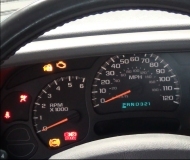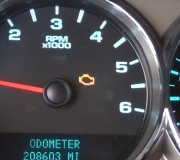Dandy. The next thing then is to view the "idle steps" on a scanner. If you don't have a scanner, you'll need to visit a mechanic. Be aware there are more and more very inexpensive units becoming available that will do this, but they are very slow in updating their screens. I bought one on eBay a few years ago for my cousin, and while it works well, it can take three or four seconds for the readings to update. That's okay for occasional use, but much too slow when we have to charge by the hour. Regular scanners update the displayed readings up to a dozen times per second.
The idle control sensor you listed isn't actually a sensor. It's a "stepper" motor controlled by the Engine Computer. It doesn't have brushes as you would normally think of a motor. Instead, it has four electromagnetic coils that are pulsed with varying voltages and polarities to cause the armature to slowly rotate to the desired position. As it rotates, it extends or retracts a pintle valve on a threaded shaft. Retracting it exposes more of an air bypass passage around the throttle blade. That lets more air in. At the same time, the computer increases the number of milliseconds it pulses the injectors open. Those two things control idle speed.
From fully closed to fully open takes 256 steps. With a properly running engine, a typical step you could expect to see is step 32. With a single cylinder misfire on a V-8 engine, a typical value would be around step 50. It has to make the working seven cylinders work harder to maintain idle speed.
To put this in perspective, a Jeep instructor wanted to show us how much control the computer had through that idle speed motor. He kept unplugging injectors on the running engine. With each additional one, idle speed dropped, the computer saw that, increased the step number, and brought idle speed back up to where it should be. At the end of the demonstration, he had seven injectors unplugged. Obviously the engine ran very poorly with horrendous vibration, but it did maintain the desired speed on just the one working cylinder, and it hadn't even reached step 220 yet.
On yours, the actual numbers aren't what's important, but they will give us an idea of why idle speed is too low. The scanner will show "desired idle step" and "actual idle step. It will usually also show "desired engine rpm" and "actual engine rpm". If the desired rpm or the desired idle step is considerably higher than the actual values, the computer is trying to increase idle speed, but without success. That can be caused by a gummed up or sluggish idle speed motor, but more commonly it's due to that air passage being plugged with carbon. That was fairly common in the early '90s, and only on some engines, but today there's better additives in gas, so we see that less often.
If the step number is rather low, say around 15 to 25, the computer is requesting that lower idle speed. That's when we have to figure out why. This is not a condition we see very often. This would be in response to something the computer is seeing from one of its sensors. To be bad enough to cause an idle speed problem, the computer should detect something wrong with the sensor's readings or its performance and set a diagnostic fault code related to it.
The last condition we might expect to find is the idle step is at "0". That only occurs when minimum throttle hasn't been relearned. For the average driver, that seven second coast time is less than half of the typical off-ramp, or coasting up to a driveway or turn-off. That's why low idle speed problems after the battery was replaced or disconnected seem to "fix" themselves for most people. When we have to do that in the shop, we're supposed to either test-drive the car to do that relearn, or explain the need to do that to the owner.
It sounds like there has been plenty of time for this relearn to take place, so if the idle step is still shown as "0", we have to figure out why it isn't taking place. The specific things the computer needs to see include very high intake manifold vacuum, (only occurs when coasting from a higher speed with the throttle closed), roughly 0.5 volts from the throttle position sensor, indicating closed throttle, the brake pedal is not pressed, engine speed is dropping, and this all takes place over at least seven seconds. That means it won't work to just snap the throttle in the shop. You'll get high vacuum, but for only one or two seconds.
The signal voltage from the throttle position sensor will vary at idle between one sensor and another which is why the computer needs to learn the value this one develops. Once that is learned, the computer knows that any time it sees that value, it has to be in control of idle speed. With any voltage, even a few hundredths of a volt higher, it leaves engine speed up to you. If it ever sees a lower voltage, it immediately puts that new value in memory as the minimum throttle voltage. A badly worn shaft in the throttle body assembly could cause that. If the TPS said 0.495 volts, for example, when the vehicle hit a bump in the road, the computer will need to see that again to control idle speed. If most of the time the TPS reads 0.500 volts at closed throttle, minimum throttle isn't being reached yet. The computer thinks you have your foot on the accelerator pedal, so it leaves engine speed up to you.
A similar thing can happen if the throttle cable or cruise control cable is too tight. That would have the same effect as holding the accelerator pedal down a little all the time. The clue here to the computer is the TPS voltage will not remain steady. Normal engine or road vibration would make the TPS bounce around just a few hundredths of a volt, but that mimics holding your foot on the accelerator pedal. It's impossible for the signal voltage to remain solid, so the computer knows the throttle isn't at rest against its stop.
All of these things are possible, but very uncommon, but we're looking for an uncommon cause. A more common cause is a brake light switch that's out of adjustment. When the pedal vibrates from road bumps, it can cause the switch to partly turn on. There's actually two, and usually three separate switches built into the brake light switch. Only one of those turns the actual brake lights on, so you may not see them flashing over bumpy roads. One potential clue is the cruise control can kick out unexpectedly on bumpy roads. There's a way to identify that with the Chrysler DRB3 scanner, but an easy work-around is to just hold the brake pedal up with your toes during the seven second coast. That won't solve the cruise control kicking out, but it can get minimum throttle learned.
What dash lights are you referring to? Are some warning lights flashing on and off? If so, which ones? Is it the entire gauge cluster with the backlights, or just certain lights? What about the brightness of the head lights? Do they flicker or do they hold steady? A test that will help with this is to measure the battery's voltage, first with the engine off, then with it running. If you need it, here's a link to an article that shows how to use a digital voltmeter:
https://www.2carpros.com/articles/how-to-use-a-voltmeter
They're using an "auto-ranging" meter here. That's an expensive feature you don't need. You can find a perfectly fine meter at Harbor Freight Tools for around $7.00. Also look at Walmart or any hardware store. I can help you set it up, if necessary.
Let me know what you find with those voltages and lights, then we'll figure out where to go next.
Monday, May 15th, 2023 AT 4:56 PM




